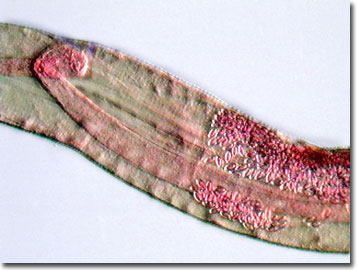Oblique Digital Image Gallery
Pinworm (Enterobius vermicularis)
Pinworms, as their common name implies, are tiny pin-shaped nematodes known as Enterobius vermicularis to the medical and zoology communities. Also called seatworms or threadworms, the small, whitish roundworms are responsible for contagious intestinal parasite infestations that commonly inflict preschool children and other crowded settings such as nurseries, schools, and hospitals.

View a second image of the Pinworm.
Although adult pinworms inhabit the large intestine, the eggs are laid outside of the anus during the night, creating a severe itching sensation. Other symptoms include disturbed sleep, decreased appetite and weight loss. Spread from person to person usually occurs with contaminated clothing, bedding, toys, and dirty hands, but the eggs can also drift through the air where they are inhaled or swallowed. Once they enter the new host, the eggs hatch in the small intestine and travel down to the large intestine for maturation.
Prevention measures, primarily through good personal hygiene with emphasis on hand washing after using the bathroom, are much more valuable than pharmaceutical treatment of outbreaks. Washing towels, bedding, and clothes in hot water and a mild bleach solution helps stem an infestation before it becomes widespread. Worm-killing medicines such as pyrantel pamoate, mebendazole, and piperazine are often prescribed, although there is some controversy in the medical community of even treating the condition.
Contributing Authors
Cynthia D. Kelly, Thomas J. Fellers and Michael W. Davidson - National High Magnetic Field Laboratory, 1800 East Paul Dirac Dr., The Florida State University, Tallahassee, Florida, 32310.
BACK TO THE OBLIQUE IMAGE GALLERY
BACK TO THE DIGITAL IMAGE GALLERIES
Questions or comments? Send us an email.
© 1995-2025 by Michael W. Davidson and The Florida State University. All Rights Reserved. No images, graphics, software, scripts, or applets may be reproduced or used in any manner without permission from the copyright holders. Use of this website means you agree to all of the Legal Terms and Conditions set forth by the owners.
This website is maintained by our
Graphics & Web Programming Team
in collaboration with Optical Microscopy at the
National High Magnetic Field Laboratory.
Last Modification Friday, Nov 13, 2015 at 01:19 PM
Access Count Since September 17, 2002: 99937
Visit the website of our partner in introductory microscopy education:
|
|
